Back to Journals » Psychology Research and Behavior Management » Volume 15
Magnitude of Depression and Its Associated Factors Among Prisoners in Arba Minch and Jinka Town, Southern Ethiopia
Authors Abdulkadir H, Girma M, Gebru Z, Sidamo NB , Temesgen G
Received 13 February 2022
Accepted for publication 9 June 2022
Published 14 June 2022 Volume 2022:15 Pages 1505—1516
DOI https://doi.org/10.2147/PRBM.S362303
Checked for plagiarism Yes
Review by Single anonymous peer review
Peer reviewer comments 3
Editor who approved publication: Dr Igor Elman
Hanan Abdulkadir,1 Meseret Girma,1 Zeleke Gebru,1 Negussie Boti Sidamo,1 Gebremaryam Temesgen2
1School of Public Health, Arba Minch University, Arba Minch Town, Ethiopia; 2Department of Midwifery, Arba Minch University, Arba Minch Town, Ethiopia
Correspondence: Hanan Abdulkadir, School of Public Health, Arba Minch University, Arba Minch Town, Ethiopia, Email [email protected]
Introduction: Globally, there is a rapid increase in the prison population, and one out of nine prisoners suffers from common mental disorders such as depression and anxiety. However, there is a limitation of study on the magnitude of depression and its associated factors among prisoners in low- and middle-income countries including Ethiopia.
Purpose: To assess the magnitude of depression and its associated factors among prisoners in Arba Minch and Jinka Town, Southern Ethiopia, 2021.
Patients and Methods: A cross-sectional study was conducted among 650 selected prisoners in Arba Minch and Jinka Town. A simple random sampling technique was used to select the study participants. Data was collected using an open data kit and then exported to SPSS version 25 for analysis. Binary logistic regression analysis with a p-value < 0.05 with a 95% confidence level was used to declare statistical significance.
Results: The magnitude of depression among the prisoners was 445 (72.0%) (95% CI: 68– 76%). Age ≥ 48 years (AOR = 3.09 95% CI 1.16– 8.28), being an urban resident (AOR = 2.21 95% CI 1.39– 3.49), using smokeless tobacco (AOR = 2.80 95% CI 1.50– 5.22), not doing physical exercise (AOR = 2.42 95% CI 1.54– 3.81), and lack of income generating job in the prison (AOR = 1.89 95% CI 1.19– 3.04) were significantly associated with depression.
Conclusion: The magnitude of depression among prisoners was high. Age ≥ 48, urban residence, using smokeless tobacco, not doing physical exercise, and lack of income-generating job in prison were significantly associated with depression. Giving special attention and being supportive to older age, prohibiting the use of smokeless tobacco; facilitating places and materials for physical exercise and creating income generating opportunities by using prisoner’s skills and available resources, giving training for the health professionals working in the prison about diagnosis and treatment of depression, additionally giving training for the prisoners how to cope up with prison life may decrease the magnitude of depression among prisoners.
Keywords: depression, prisoners, Southern Ethiopia
Introduction
Depression is a common mental disorder characterized by persistent sadness, feeling of tiredness, poor concentration, disturbed sleep and appetite, and a lack of interest or pleasure in previously rewarding or enjoyable activities.1 Depression is a leading cause of disability worldwide, and it is a major contributor to the overall global burden of disease. Approximately 280 million people in the world have depression.2 Depression is also common in Ethiopia, which is around 20.5%.3
Globally, more than 10.35 million people are held in penal institutions. Since the year 2000, the world prison population total has grown by almost 20%.4 Ethiopia has around 93,044 prisoners, which is the highest number of prisoners next to South Africa.5 According to a WHO report, one out of nine prisoners suffers from mental health disorders such as depression and anxiety.6 A systematic review showed that the prevalence of major depression is 10% and 14% for men and women, respectively.7 Studies done in Ethiopia showed that the prevalence of depression among prisoners ranges from 41.9% to 55.9%.8–12
Inmates with depression are often reported to be at risk of self-harm, having decreased quality of life before prison, and developing infectious diseases and chronic health conditions.13 Additionally, it can cause deterioration of illness, disability, and suicide. Suicide and self-harm are more likely in prisoners than in people of similar age and gender in the general population. Male prisoners have a relative risk of suicide of 3–6 times that of the general population, and female prisoners have a relative risk of more than 6 times that of the general population.7
Research findings showed that age, sex, marital status, having children, family history of mental illness, history of child abuse, not participating in income generating activity inside prison, lifetime substance use, history of chronic disease, being sentenced for more than 5 years, previous incarceration and thinking life will be difficult after release from prison were associated with depression among inmates.9–12,14–16
Considering prisoners and other vulnerable populations as the groups who need special mental health services, the Ethiopian Federal Ministry of Health (EFMOH) has developed a National Mental Health Strategy based on WHO recommendations.17 However, there is limited information related to the magnitude of depression and its associated factors among prisoners in Ethiopia, especially in the study area. So this study aims to assess the magnitude of depression and its associated factors among prisoners in the correctional institutions of Arba Minch and Jinka town. Identifying the factors that affect the depression status of prisoners during their stay in correction institutions will significantly help to develop interventions that may contribute to an enabling environment to fully access and utilize the mental health services. The findings from this research will also contribute to developing programs and policies that would improve the depression status of prisoners which ultimately improve access to and utilization of mental health services by people with depression. Moreover, local health officers will benefit from the findings of this study so that they can take evidence-based action in preventing depression among prisoners during their stay.
Materials and Methods
Study Area, Design, and Period
An institution-based cross-sectional study was conducted from July 04 up to 18, 2021 in the correction institutions of Arba Minch and Jinka town. Arba Minch town is its capital city of Gamo Zone and is located 450km from Addis Ababa and 275km from the regional town, Hawassa. Jinka town is the capital city of the South Omo zone and is located 750 km away from Addis Ababa and 520km from the regional town, Hawassa. Arba Minch town correctional institution is established in 1955E.C, and currently, the center has 1156 prisoners. Jinka Town correctional institution is established in 1967 E.C, and currently, the center has 760 prisoners. Both correctional institutions have both female and male prisoners which are remanded and sentenced. The institutions have clinics that are responsible for the Gamo zone health department and the South Nation health bureau. The clinic employed nurses and public health officers.
Source and Study Population
The source populations were all prisoners held at Arba Minch and Jinka town correctional institutions. Whereas the study populations were all prisoners who were available during the study period and fulfill inclusion criteria.
Inclusion and Exclusion Criteria
Inclusion Criteria
All prisoners who were ≥18 years old and held in one of the correctional institutions during the study period were included in this study.
Exclusion Criteria
Those prisoners who were waiting for trial, critically sick during data collection, and prisoners openly imprisoned were excluded from the study.
Sample Size Determination
A total of 650 sample size was calculated using the single population proportion formula by assuming a 95% confidence interval, 4% margin of error, and the proportion of depression among prisoners 56.4% taken from a study done in Hawassa, Southern Ethiopia12 and 10% non-response rate.
Sampling Technique and Procedure
All prisons in Arba Minch and Jinka town were included in this study. The total number of prisoners was identified in each prison. Then, proportional to size allocation was applied to each prison. A simple random sampling technique was used to select the study participants to be included in the study from the sampling frame obtained from registration books at the correctional center. Finally, the randomly selected prisoners were identified and interviewed at a place arranged for an interview (Figure 1).
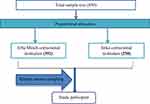 |
Figure 1 Presentation of sampling procedure on magnitude of depression among prisoners in Arba Minch and Jinka town, Southern Ethiopia, 2021. |
Study Variables (Table 1)
Operational Definitions
Depression
For measuring the depressive symptom, Patient Health Questioner with a nine-item version (PHQ-9) was used. Depression total scores were computed for every one of the participants by adding scores of all the nine items of the scale. A participant was considered to be in a state of depression if he/she scored five and above.10,11,18
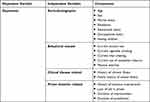 |
Table 1 Variables to Assess Magnitude of Depression Among Prisoners in Correctional Institutions of Arba Minch and Jinka Town, Southern, Ethiopia, 2021 |
Chronic Illness
Having one of the diseases like diabetes, hypertension, eye problem, heart disease, HIV, or kidney disease. Report from the patient was confirmed by the health professional.
Data Collection Tool and Procedures
Data were collected by using a pretested structured interviewer-administered questionnaire having five parts. These were socio-demographic, behavioral factors, clinical disease-related factors, prison situation-related factors, and PHQ-9. Each question on PHQ-9 measures a problem that the prisoners were bothered by in the last 15 days. The depressive symptom was rated on a scale ranging from zero (not at all) to three (nearly every day). Depression total scores were computed for every one of the participants by adding scores of all the nine items of the scale. A participant was considered to be in a state of depression if he/she scored five and above.10,11 PHQ-9 had been translated and validated in Ethiopia previously.18 The reliability analysis was done for the PHQ-9 item, and the result showed a good score of internal consistency with 0.905 Cronbachs' alpha, 9.81 mean, 7.386 Std. Deviation and 0.392 Inter-Item Correlations range. The tool was first developed in the English language and translated to the Amharic language then back to the English language to check the consistency. Ten10 data collectors and six6 supervisors (five data collectors and three supervisors for each correctional institution) who were health professionals who had direct experience and the ability to speak the Amharic language were recruited for data collection.
Data Quality Assurance
Data quality was ensured during instrument development, collection, coding, and analysis. The supervisors and data collectors were trained about the purpose of the study and how to supervise and collect questionnaires, respectively. The tool was pre-tested on 5% of the study participants in a correctional institution of Sawla correctional institution (which is not included in this study) before the actual data collection. During data collection, the questionnaire was checked for its completeness daily by supervisors and then by investigators. Intensive supervision was carried out by the assigned trained supervisors and research team members throughout the data collection period. This helped to identify problems that were addressed in the questionnaires.
Data Processing and Analysis
Data was collected with ODK and then exported to SPSS version 25 for analysis. After data cleaning and editing, the frequency distribution of socio-demographic characteristics was analyzed. Then, a binary logistic regression analysis was performed for each independent variable and outcome of interest to identify independent factors associated with the outcome. Upon the completion of the binary logistic regression analysis, variables with a p-value <0.25 were selected for the multiple logistic regression analysis. Context and previous studies were also considered to make a variable candidate for multivariable analysis. To decide whether or not a variable is significant, the p-value associated with each parameter was estimated using the p-value less than 0.05 as a cut-off point. The crude and adjusted odds ratios together with their corresponding 95% confidence intervals were computed and interpreted accordingly. Multi-collinearity assumptions were assessed using the variance inflation factor (VIF). The goodness-of-fit test for the final model was checked by Hosmer and Lemeshow test.
Ethical Consideration
Ethical approval was obtained from the Institutional Review Board (IRB) of Arba Minch University, College of Medicine and Health Sciences with IRB reference number of IRB/80/2019. Permission to conduct the research was obtained from prison authorities after giving a formal supportive letter was obtained from research coordination offices. Written consent was obtained from the study participants after explaining the purpose of the study. Participants were assured that their names will not be stated, data will be kept confidential and it will be used only for research purposes. They were also informed that they are not forced to answer the entire question, and they can withdraw at any time if they do not want to participate. All data collectors and supervisors used personal protective equipment based on WHO standards during the training and data collection period to prevent the COVID 19 pandemic disease transmission. Besides, this study was conducted following the Declaration of Helsinki, and all ethical and professional considerations were followed throughout the study to keep participants’ data strictly confidential.
Result
Socio-Demographic Characteristics
From the total sample size, 618 participants were volunteers making the response rate 95.08%. Almost half of the respondents 301 (48.7%) were in the age category of 18–27, and the mean age of the participants was 31.54 (standard deviation, 12.65). The majority 500 (80.9%) of the respondents were male. About 331 (53.6%) of respondents reside in rural areas. More than half 375 (60.7%) of the respondents were married. About 111 (18.0%) of participants do not attend formal education and 51 (8.3%) of them were unemployed. More than half 399 (64.6%) of the respondents had a child (Table 2).
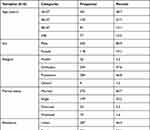 |
Table 2 Socio-Demographic Characteristic of Prisoners in Arba Minch and Jinka Town, Southern Ethiopia, 2021 |
Behavioral Characteristics
Out of the total participants, ninety-four (15.2%) participants used smokeless tobacco. More than one-third 235 (38.0%) of the respondents did a physical exercise for at least for 30 minutes. Out of them 66 (28.1%) did physical exercise every day (Table 3).
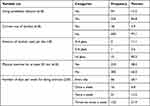 |
Table 3 Behavioral Characteristic of Prisoners in Arba Minch and Jinka Town, Southern Ethiopia, 2021 |
Clinical Characteristics
Of the total respondents, 279 (45.1%) of them had reported that they have been told that they have a chronic disease by a health professional. Out of them 10 (1.6%) were diabetic, 27 (4.4%) were hypertensive and 15 (3.4%) were HIV positive. Less than one-third 67 (10.8%) of the participants had a family history of mental illness (Table 4).
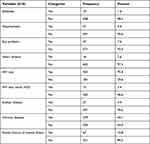 |
Table 4 Clinical Characteristics of Prisoners in Arba Minch and Jinka Town, Southern Ethiopia, 2021 |
Prison Situation
The majority 443 (71.7%) of the participant’s duration of punishment was greater than five years. More than one-third 248 (40.1%) of the participants stayed in prison for about 1–5 years. About 45 (7.3%) of the participants had a history of the previous incarceration. Of them, 30 (28.9%) participants were incarcerated two or above times. The majority 433 (70.1%) of the participants do not participate in income-generating jobs in prison (Table 5).
 |
Table 5 Prison Situation of Prisoners in Arba Minch and Jinka Town, Southern Ethiopia, 2021 |
Magnitude of Depression
The magnitude of depression was 445 (72.0% (95% CI: 68–76%)). About 104 (16.8%) of the prisoners had little interest or pleasure in doing things every day. Less than on third 163 (26.4%) of the participants were feeling down, depressed or hopeless for nearly half the days. Ninety-seven (15.7%) of the prisoners had trouble falling asleep or sleeping too much every day. Seventy-eight (12.6%) of the participants had thoughts that they would be better off dead or hurting themselves in some way every day (Table 6).
 |
Table 6 Magnitude of Depression on Prisoners in Arba Minch and Jinka Town, Southern Ethiopia, 2021 |
Factors Associated with Depression
The bivariable logistic regression result showed that age, sex, marital status, residence, educational status, occupation, having child, using smokeless tobacco, physical exercise, chronic disease, family history of mental illness, participation in income generating job in prison, duration of punishment, duration of imprisonment and previous incarceration were a candidate for multivariable analysis. Then, age, residence, using smokeless tobacco, physical exercise, and participation in the income-generating job in prison were significantly associated with depression. The multicollinearity between the independent variables was checked and there was no multicollinearity.
Those prisoners whose age was ≥48 were 3.09 (95% CI 1.16–8.28) times more likely to develop depression than those whose age was 18–27. The odds of developing depression were 2.21 (95% CI 1.39–3.49) times higher among urban residents than rural residents. Inmates who use smokeless tobacco were 2.80 (95% CI 1.50–5.22) times more likely to develop depression than those who do not use it. Those participants who did not do physical exercise were 2.42 (95% CI 1.54–3.81) times more likely to develop depression than those who did physical exercise. The odds of developing depression were 1.89 (95% CI 1.19–3.04) times higher among inmates who had no income-generating job in prison compared with those who had income-generating jobs in prison (Table 7).
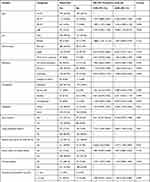 |
Table 7 Factors Associated with Depression Among Prisoners in Arba Minch and Jinka Town, Southern Ethiopia, 2021 |
Discussion
The finding of this study showed that the magnitude of depression among prisoners was 72.0% (95% CI: 68–76%). This finding was comparable with the study done in Nigeria (72.6%).19 However, it was higher than the study done in America (43%), Iran (27.9%), Nepal (35.3%), Pakistan (59.4%), Uganda (44%), North West Amhara (43.8%), Bahir Dar (45.9%), Tigray (55.9%), Jimma (41.9%), and Southern Ethiopia (56.4%).8–12,15,16,20–22 But it was lower than the study done in Pakistan (85%).23 These discrepancies may be due to the differences in measurement tool, target population, sample size, and socio-culture differences between Ethiopia and the other countries.
Prisoners whose age was ≥48 were 3 times more likely to develop depression than those whose age was 18–27. This finding goes in line with the study done in America.20 This might be explained by those who are older age may feel pressure due to social and family responsibilities also those younger ages may have hope to continue their life after imprisonment. The odds of developing depression were 2 times higher among urban residents than rural residents. This finding is supported by the study done in Pakistan.15 This could be explained by those who were urban dwellers may face economic stress and affordability in the city for their family than rural dwellers. Also, urban dwellers may adopt a good living style and electronic materials like a phone. So being departed from this life may expose them to depression than rural dwellers. Inmates who use smokeless tobacco were 3 times more likely to develop depression than those who do not use it. This finding was similar to the study done in the USA.24 The probable reason could be being dependent on the smokeless tobacco may add additional stress to accommodate the tobacco. However, the connection between smokeless tobacco and depression needs further study. Those participants who did not do physical exercise were 2 times more likely to develop depression than those who did physical exercise. This is because physical exercise makes several neurotransmitters in the brain, like serotonin, dopamine, and noradrenaline that function the same way as the SSRI antidepressants.25 Also, physical exercise is important in maintaining the proper functioning of the hypothalamic–pituitary–adrenal (HPA) axis, and several studies have demonstrated dysfunction of the HPA axis in people suffering from mental disorders.26 Additionally, it might divert prisoners from a sleep disorder and use smokeless tobacco. The odds of developing depression were 2 times higher among inmates who had no income-generating job in prison compared with those who had income-generating jobs in prison. This finding agrees with the studies done in Jimma and Southern Ethiopia.11,12 Having day-to-day objective-oriented jobs may make the prisoners less stressed and spent their time. It also gives them hope for life. Additionally, making money may make life easy since it can make them accommodate their need.
The limitation of this study was being cross-sectional design, which does not establish a temporal relationship between cause and effect, and the self-report from the prisoners may lead to bias. The study’s strength was having a large sample size which is representative of the whole prison population. It is recommended that the prison authority prohibits the use of smokeless tobacco; facilitates places and materials for physical exercise; and creates income-generating opportunities by using prisoners’ skills and available resources. Also, the Gamo Zone Health Department, the South Nation Health Bureau, and Arba Minch University in collaboration arrange training for the health professionals working in the prison on diagnosis and treatment of depression. Additionally, interventional studies may also be relevant.
Conclusion
The magnitude of depression among prisoners was high. Age ≥48, urban residence, using smokeless tobacco, not doing physical exercise, and lack of income-generating job in prison were significantly associated with depression. Giving special attention and being supportive to older age, prohibiting the use of smokeless tobacco; facilitating places and materials for physical exercise and creating income generating opportunities by using prisoner’s skills and available resources, giving training to the health professionals working in the prison about diagnosis and treatment of depression, additionally giving training for the prisoners how to cope up with prison life may decrease the magnitude of depression among prisoners.
Disclosure
The authors report no conflicts of interest in this work.
References
1. World Health Organisation. Depression: definition. World Health Organisation; 2016. Available from: http://www.euro.who.int/en/health-topics/noncommunicable-diseases/pages/news/news/2012/10/depression-in-europe/depression-definition.
2. WHO. WHO fact sheet; 2021. Available from: https://www.who.int/news-room/fact-sheets/detail/depression.
3. Bifftu BB, Takele WW, Guracho YD, Yehualashet FA. Depression and its help seeking behaviors: a systematic review and meta-analysis of community survey in Ethiopia. Depress Res Treat. 2018;2018:43–47.
4. Stevenson WJ. World prison population list. World Prison Br. 2016;2016:1–15.
5. Ispas M. SA has most prisoners in Africa; 2014. Available from: https://news.yahoo.com/sa-most-prisoners-africa-report-111248402.html.
6. WHO. Trencin statement on prisons and mental health; 2008:38. Available from: http://www.euro.who.int/__data/assets/pdf_file/0006/99006/E91402.pdf.
7. Fazel S, Hayes AJ, Bartellas K, Clerici M, Trestman R. Mental health of prisoners: prevalence, adverse outcomes, and interventions. Lancet Psychiatr. 2016;3(9):871–881. doi:10.1016/S2215-0366(16)30142-0
8. Beyen TK, Dadi AF, Dachew BA, Muluneh NY, Bisetegn TA. More than eight in every nineteen inmates were living with depression in prisons of Northwest Amhara Regional State, Ethiopia, a cross-sectional study design. BMC Psychiatr. 2017;17(1):1–9. doi:10.1186/s12888-016-1179-9
9. Welu SG, Aregawi DH, Gebreslassie HT, Kidanu KG. Prevalence and associated factors of depressive disorder among prisoners in Mekelle General Prison Center, Tigray, Ethiopia: a cross-sectional study design. Depress Res Treat. 2021;2021. doi:10.1155/2021/1942674
10. Alemayehu F, Ambaw F, Gutema H. Depression and associated factors among prisoners in Bahir Dar Prison, Ethiopia. BMC Psychiatr. 2019;19(1):1–7. doi:10.1186/s12888-019-2071-1
11. Abdu Z, Kabeta T, Dube L, Tessema W, Abera M. Prevalence and associated factors of depression among prisoners in Jimma Town Prison, South West Ethiopia. Psychiatry J. 2018;2018:1–10. doi:10.1155/2018/5762608
12. Bedaso A, Kediro G, Yeneabat T. Factors associated with depression among prisoners in southern Ethiopia: a cross-sectional study. BMC Res Notes. 2018;11(1):1–6. doi:10.1186/s13104-018-3745-3
13. Shinkfield AJ, Graffam J, Meneilly S. Co-morbidity of conditions among prisoners. 2009:350–365.
14. Affizal A, Hazrina MN. Stress and depression: a comparison study between men and women inmates in Peninsular Malaysia. Int J Humanit Soc Sci. 2014;4(2):153–160.
15. Khan TM, Hussain H, Khan G, Khan A, Badshah A, Sarwar R. Incidence of depression among incarcerated woman in Central Prison, Peshawar, Pakistan. Eur J Gen Med. 2012;9(1):33–38.
16. Shrestha G, Yadav DK, Sapkota N, et al. Depression among inmates in a regional prison of eastern Nepal: a cross-sectional study. BMC Psychiatr. 2017;17(1):1–9. doi:10.1186/s12888-017-1514-9
17. Federal Democratic Republic. Federal Democratic Republic of Ethiopia Ministry of Health NATIONAL MENTAL. 2015.
18. Hanlon C, Medhin G, Selamu M, et al. Validity of brief screening questionnaires to detect depression in primary care in Ethiopia. J Affect Disord. 2015;186:32–39. doi:10.1016/j.jad.2015.07.015
19. Osasona SO, Koleoso ON. Prevalence and correlates of depression and anxiety disorder in a sample of inmates in a Nigerian prison. Int J Psychiatry Med. 2015;50(2):203–218. doi:10.1177/0091217415605038
20. Rowell TL, Draine J, Wu E. Depression in a random sample of incarcerated African-American Men. Psychiatr Serv. 2011;62(1):103–104.
21. Sepehrmanesh Z, Ahmadvand A, Akkasheh G, Saei R. Prevalence of psychiatric disorders and related factors in male prisoners. Iran Red Crescent Med J. 2014;16(1):1–6. doi:10.5812/ircmj.15205
22. Ben FJ, Ashaba S, Rukundo GZ, Hagl M, Rosner R. Prevalence and associated factors of mental disorders among prisoners in Mbarara municipality, southwestern Uganda: a cross-sectional study. BMC Psychiatr. 2019;19(1):1–8. doi:10.1186/s12888-018-1996-0
23. Shahid I, Aftab MA, Yousaf Z, Naqvi SH, Hashmi AM. Prevalence of depression among male prisoners at an urban jail in Pakistan. Healthmed. 2014;8(6):699–704.
24. Fu Q, Vaughn MG, Wu LT, Heath AC. Psychiatric correlates of snuff and chewing tobacco use. PLoS One. 2014;9(12):1–14. doi:10.1371/journal.pone.0113196
25. Valizadeh R, Veisani Y, Delpisheh A, Kikhavani S, Sohrabnejad A. Major depression and psychiatric disorders in Iranian prisoners based on a clinical interview: a systematic review and meta-analysis. Shiraz E Med J. 2017;18(6). doi:10.5812/semj.44979
26. Anderson E, Shivakumar G. Effects of exercise and physical activity on anxiety. Front Psychiatry. 2013;4:10–13. doi:10.3389/fpsyt.2013.00027
 © 2022 The Author(s). This work is published and licensed by Dove Medical Press Limited. The full terms of this license are available at https://www.dovepress.com/terms.php and incorporate the Creative Commons Attribution - Non Commercial (unported, v3.0) License.
By accessing the work you hereby accept the Terms. Non-commercial uses of the work are permitted without any further permission from Dove Medical Press Limited, provided the work is properly attributed. For permission for commercial use of this work, please see paragraphs 4.2 and 5 of our Terms.
© 2022 The Author(s). This work is published and licensed by Dove Medical Press Limited. The full terms of this license are available at https://www.dovepress.com/terms.php and incorporate the Creative Commons Attribution - Non Commercial (unported, v3.0) License.
By accessing the work you hereby accept the Terms. Non-commercial uses of the work are permitted without any further permission from Dove Medical Press Limited, provided the work is properly attributed. For permission for commercial use of this work, please see paragraphs 4.2 and 5 of our Terms.
